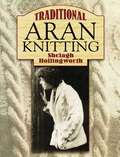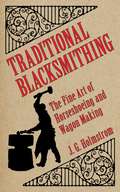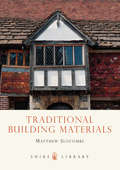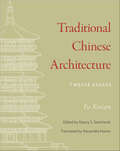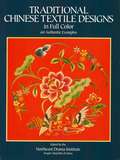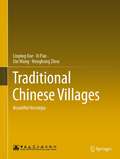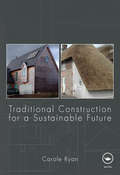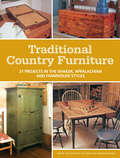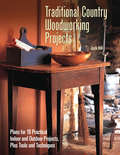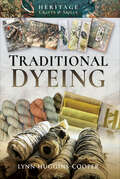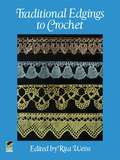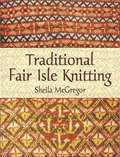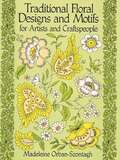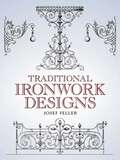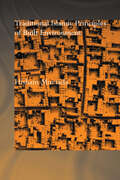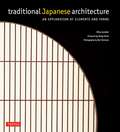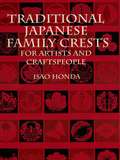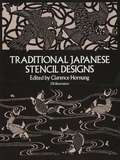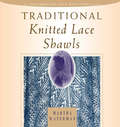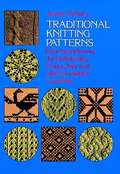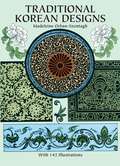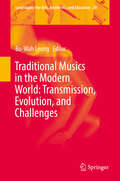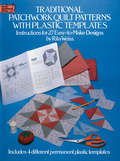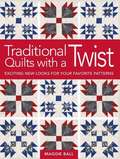- Table View
- List View
Traditional Aran Knitting
by Shelagh HollingworthMore than 20 fully illustrated project patterns for knitters of all abilities. Known and prized around the world in the form of the "Irish fisherman's sweater," Aran knitting originated generations ago in the chilly, windswept islands of Galway Bay. The seafaring Aran Islanders developed a distinctive method of crafting heavy wool into snug garments resistant to the stormiest weather. These clothes also happen to be extremely stylish, with distinctive, highly textured patterns of cables and ropes.Suitable for novices to the Aran style as well as for experienced knitters, this guide offers start-to-finish advice. More than 20 patterns, illustrated by 117 close-up photographs, include:* Traditional fisherman's sweater* Family sweater, with round, polo, or V-neck* Cardigans* Jackets and coats* Hat, mittens, and scarf set* Cushion coversTraditional Aran Knitting also explains the history of the craft and the meaning behind the coded "messages" woven into the unique Aran patterns.
Traditional Blacksmithing: The Fine Art of Horseshoeing and Wagon Making
by J G HolmstromOnly an experienced blacksmith with genuine care for his craft and the livelihood of all blacksmiths could produce such a wonderful guide. Holmstrom provides not just practical instruction for all manner of small-scale blacksmith work, but intersperses his guidance with more general life lessons for blacksmiths, such as not falling prey to "habits of intemperance." More than a snapshot of a bygone era, the style and the content of Traditional Blacksmithing will appeal to readers of today, thanks to Holmstrom's generous and patient approach. Topics covered include: setting up shop, building your own machinery, repairing horse hooves, fixing your tools, and even building a strong reputation in the community.
Traditional Building Materials
by Matthew SlocombeSteel and glass now dominate modern British cities, but the country can still boast millions of older houses constructed of more traditional building materials. Many date from the period before easy nationwide transportation, when these materials were usually grown on or extracted from land in the locality. As a result, Britain has a varied legacy of vernacular buildings that echoes its multitude of different landscapes. They display a rich and colourful palette of materials from the honey-coloured stone of the Cotswolds, to the red earth of Devon and grey granite of Aberdeen. In this book, buildings historian Matthew Slocombe explores the way in which locally produced constructional resources have shaped Britain's architectural heritage, whether workers' cottages or country houses. He looks at the range of materials used for walls and roof coverings, and explores the processes needed for their extraction, production and manufacture. He also considers the wealth of craft skills required for their use, including masonry, carpentry, roofing, leadwork and much more.
Traditional Chinese Architecture: Twelve Essays (The Princeton-China Series)
by Fu XinianA groundbreaking book by one of the world's leading historians of Chinese architectureTranslated by Alexandra Harrer.Fu Xinian is considered by many to be the world's leading historian of Chinese architecture. He is an expert on every type of Chinese architecture from every period through the nineteenth century, and his work is at the cutting edge of the field. Traditional Chinese Architecture gathers together, for the first time in English, twelve seminal essays by Fu Xinian. This wide-ranging book pays special attention to the technical aspects of the building tradition since the first millennium BC, and Fu Xinian's signature drawings abundantly illustrate its nuances.The essays delve into the modular basis for individual structures, complexes, and cities; lateral and longitudinal building frames; the unity of sculpture and building to create viewing angles; the influence of Chinese construction on Japanese architecture; and the reliability of images to inform us about architecture. Organized chronologically, the book also examines such topics as the representation of architecture on vessels in the Warring States period, early Buddhist architecture, and the evolution of imperial architecture from the Tang to Ming dynasty. A biography of Fu Xinian and a detailed Chinese-English glossary are included.Bringing together some of the most groundbreaking scholarship in Chinese architectural history, Traditional Chinese Architecture showcases an uncontested master of the discipline.
Traditional Chinese Textile Designs in Full Color
by Northeast Drama InstituteSixty authentic full-color motifs drawn from highly stylized opera traditions. Symbolic representations of dragons, lions, phoenixes, mandarin ducks, cranes, peonies, lotuses, much more. Vibrant color, subtle hues, beautifully rendered illustrations. Invaluable source of authentic Chinese design and color. Descriptive captions.
Traditional Chinese Villages: Beautiful Nostalgia
by Xin Wang Linping Xue Xi Pan Honghong ZhouThis book uses the concept of the region to introduce traditional Chinese villages in ten typical areas. Most of the villages have been included in the World Cultural Heritage List or the Tentative List and reflect the diversity of rural and traditional life. Richly illustrated with pictures of architectural decorations, dwellings, day-to-day country life and aerial views of settlements, it not only enhances readers’ knowledge of China’s traditional architectural culture but also provides inspiration for architectural creation. It is a valuable resource for graduate students, lecturers and researchers in the field of traditional villages, heritage conservation and Chinese architectural culture.
Traditional Construction for a Sustainable Future
by Carole RyanSince the spread of classical design and construction amongst the upper echolons of British society in the late seventeenth century, traditional construction methods have largely fallen by the wayside. Centuries later, as the construction industry faces up to its environmental responsibilities, this book explores its rich and ancient tradition to provide tried and trusted solutions to modern day construction problems. By way of introduction, the ancient and historical lifestyles that dictated the nature of traditional construction are explored, before focussing on its health and ecological benefits. As well as cultural background, this book includes a detailed scientific description of traditional building materials and their constituents which draws a sharp contrast with modern petrochemical-based materials. The studies of traditional buildings included reveal the sustainability of features such as natural ventilation and breathing walls, and comparisons with modern construction methods show how they could prevent 'sick building syndrome'. The author argues that maintenance for long life, by contrast with the modern concept of life-cycle costing, is at the nub of sustainability and underlies the contribution traditional building construction can make to tackling climate change. Over 250 original photos, and over fifty bespoke diagrams illustrate the features, techniques, and characteristics of traditional construction that could make such a valuable contribution to the industry today. The inclusion of a close study of how these methods relate to British building regulations makes this book a practical guide for construction professionals, as well as an authoritative resource for students and policy-makers.
Traditional Country Furniture: 21 Projects in the Shaker, Appalachian and Farmhouse Styles
by Editors of Popular WoodworkingCountry Furniture That Says Quality! Country furniture styles convey a sense of simple comfort and the warmth of hearth and home. While some country furniture can be rustic, the pieces included in Traditional Country Furniture are of quality construction and design, drawing from the best of traditional American furniture styles. Each furniture piece includes step-by-step photos and instructions, with a variety of skill levels represented. Projects include: Kentucky sideboard Blanket chest Country wall shelf Tavern table Burlington Farmer's Desk Drop-leaf kitchen table Tall clock and more!
Traditional Country Woodworking Projects
by Jack HillJoin the do-it-yourself revolution that’s swept cities, suburbs, and rural areas across the country. More and more people are realizing the satisfaction and enjoyment of making items that are as beautiful and interesting as they are practical. Crafters and folk-art enthusiasts alike will enjoy this comprehensive woodworking guide for all experience and skill levels, with detailed instructions on eighteen home projects for both hand and power tools. Inside Traditional Country Woodworking Projects: *The necessity and prominence of woodworking through the ages *The resurgence of interest in country-style designs from past centuries *Required woodworking tools and how to use them *Essential techniques, including drawing, measuring, planing, joining, and many more, with which woodworkers of all skill levels should be familiar *Step-by-step fully illustrated instructions for eighteen classic designs, including kitchen implements, toys, home décor, and furniture *Detailed dimensions, materials lists, cutting lists, and notes for each project as well as templates for special shapes
Traditional Dyeing (Heritage Crafts & Skills)
by Lynn Huggins-CooperThis book offers a whistle-stop guide to the history of dyeing. The story begins in prehistory when people discovered and used the glory of colors created by earth pigments, plants and more. We move through history from the medieval dye gardens to the horrors of chemical dyes from the Victorian era that damaged watercourses, created pollution and caused terrible sickness and untold deaths. Today, along with safe commercial dyes, modern ‘cottage industries’ are once more the leaders in the innovative use of dye plants. The second part of the book brings us up to date, via interviews with modern day artisans. These dye workers generously allowed the author access to their studios and creative lives and discussed the way they use and adapt traditional methods, techniques and tools for the twenty-first century. Photos of their craft offers a unique window into the world of dyes. Finally, if you are inspired to try your hand at this fascinating craft, the book has a section that explains simple eco dyeing and planning your own dye garden. It also has a resources section containing a valuable list of suppliers of plants, seeds, dyes, tools and materials, as well as information about training courses, useful websites and more – everything you need to get started!
Traditional Edgings to Crochet
by Rita WeissFor the enthusiastic crocheter who may not have the time to make tablecloths or bedspreads, crocheted edgings offer a popular and enduring alternative. With more than 130 patterns to choose from in this attractive collection, crocheters can personalize an item by simply adding a delicate, handmade finishing touch.Assembled by noted needlework authority Rita Weiss, the selections in this volume have been reprinted from rare thread-company leaflets published in the 1940s and 50s. (Many of these instruction books -- originally created to sell thread -- are collector's items today.) Needleworkers will be delighted with the wide range of heirloom-quality patterns that include traditional filet crochet and filigree designs, as well as floral motifs incorporating such familiar blooms as the pansy, rose, forget-me-not, buttercup, and aster. Clear, step-by-step instructions make these patterns easy to work anywhere -- in the home, at meetings, or on public transportation.Crocheters will want to use these lovely edgings again and again on a variety of personal and household items such as handkerchiefs, napkins, placemats, collars, cuffs, lingerie, pillowcases, and much more.
Traditional Fair Isle Knitting
by Sheila McgregorSituated far to the north of the Scottish mainland, the Shetlands are famous for the dampness of their climate and the excellence of their wool -- a pair of distinctions that fostered the development of a vibrant form of patterned knitting. Fair Isle's unusual technique employs two colors in each row; the wool not in use is stranded along the back in short loops, resulting in an extremely warm and weatherproof double fabric.In this definitive guide, the author shows how any circular-method knitting technique can yield the popular Fair Isle patterns. Its treasury of designs features more than 70 pages of patterns that can be used for mittens, jerseys, jackets, and hats. In addition, its practical advice on designing garments and the use of color offers valuable assistance to knitters who wish to create their own patterns and seek the inspiration for an endless array of variations and adaptations.Long out of print, this volume is well known as the best source of authentic Fair Isle patterns. Its republication offers a new generation of knitters a reliable resource for projects in the traditional and much-loved style. 31 halftones and 17 color illustrations.
Traditional Floral Designs and Motifs for Artists and Craftspeople (Dover Pictorial Archive)
by Madeleine Orban-SzontaghRe-create a lovely spray of wild roses that once bloomed in abundance on an early nineteenth-century fabric. Duplicate a lush Persian floral print from a kerchief worn in the waning days of the acien régime. These and dozens of other superb royalty-free designs -- adapted from patterns on antique textiles -- are available now to artists and craftspeople in this attractive collection.A noted artist and surface designer has masterfully rendered nearly 230 designs from French, English, German, Swiss, and Russian textiles of the eighteenth and nineteenth centuries. Featured are profusions of flowers, leaves, sprays, branches, fruits, and birds in a wide variety of formats: clusters, bouquets, single vignettes, and more. Also shown are several full-page motifs with a single large, elaborate flower. Captions supply a brief description, date, and place of origin for the designs on each page.Among the many charming samples are floral and butterfly blockprints from Alsace in France (c. 1790), a Kashmir floral motif from England (1805), an English rose bouquet (1834), berries and flowers from Switzerland (1820), and scores of others.
Traditional Ironwork Designs (Dover Pictorial Archive)
by Josef FellerFrom an exceptional collection of the finest examples of German ironwork comes this rich source of royalty-free images for artists and craftspeople. More than 270 illustrations depict a broad variety of magnificent ironworks from the city of Düsseldorf, with finely rendered examples of the craft ranging from elaborate castle gates to ornate weather vanes.Balustrades, screens, balcony railings, and other decorative ironworks abound in this handsome compilation. Derived from a rare, turn-of-the-century portfolio, these splendid designs offer uncommon glimpses of a rich array of motifs that are sure to inspire and delight designers, architecture enthusiasts, antique lovers, and devotees of vintage ironwork.
Traditional Islamic Principles of Built Environment
by Hisham MortadaWritten with the non-Muslim reader in mind, this book analyses the principles and values established by Islamic tradition to govern the social and physical environments of Muslims.The picture of Islam that emerges from this work is of a way of life with social ideals. Relying on the Qur'an and Sunna, the basic sources of Islamic law, and using examples of the built environment of early Muslims in North Africa, the Middle East, Europe and Central Asia, the author explains how following these ideals can create an urban environment that responds to social and environmental variables.Islamic views on the controversial issue of modernisation are also examined.This book will be of interest to people in the fields of urban planning, architecture, sociology, anthropology, housing and built environment, as well as Islamic studies.
Traditional Japanese Architecture
by Mira Locher Ben Simmons Kengo Kumahick thatched roofs and rough mud plaster walls. Intricate carved wood transoms and precisely woven tatami mats--each element of traditional Japanese architecture tells a story. InTraditional Japanese Architecture, author Mira Locher explores how each of these stories encompasses the particular development, construction, function and symbolism inherent in historic architectural elements. From roofs, walls and floors to door pulls and kettle hangers, Traditional Japanese Architecture situates these elements firmly within the natural environment and traditional culture of Japan.
Traditional Japanese Architecture
by Mira Locher Ben Simmons Kengo Kumahick thatched roofs and rough mud plaster walls. Intricate carved wood transoms and precisely woven tatami mats--each element of traditional Japanese architecture tells a story. InTraditional Japanese Architecture, author Mira Locher explores how each of these stories encompasses the particular development, construction, function and symbolism inherent in historic architectural elements. From roofs, walls and floors to door pulls and kettle hangers, Traditional Japanese Architecture situates these elements firmly within the natural environment and traditional culture of Japan.
Traditional Japanese Family Crests: for Artists and Craftspeople
by Isao HondaOver 1,700 compact, graceful designs -- a traditional part of many Japanese family histories -- are featured in this handsome, versatile collection. Depicting plant, leaf, animal, and fan designs in circular motifs; astronomical images, and more, the authentic, royalty-free crests are ideal for use as spot illustrations in a variety of graphic projects.
Traditional Japanese Stencil Designs (Dover Pictorial Archive)
by Clarence HornungThe demand by artists and craftspeople for visually exciting designs has created renewed interest in traditional Japanese motifs which are ideal for modern decorative and graphic needs.This comprehensive archive presents 276 exquisite Japanese stencil designs, inspired by natural themes and developed to ideographic perfection through the centuries. Sky, seam and land birds, beasts, insects, and countless flora and fauna comprise Japanese design vocabulary.Versatile motifs include clouds, sun, stars, waves, birds, butterflies, dragonflies, fish, and delicate floral and foliate patterns — chrysanthemum, plum and cherry blossoms, bamboo, ivy, wisteria, oak and maple leaves, and much more. You'll also find abstract and geometric designs — circles, squares, diamonds, polygons, stripes, bands, and lattice motifs — as well as fans, wheels, umbrellas, and other man-made objects.
Traditional Knitted Lace Shawls
by Martha Waterman NicholsTimeless and beautiful shawls from Ireland, Scotland, and Wales in an array of shapes with openwork, textured stitches, and lace edgings. Everything you need to know to design and knit your own shawls is provided.
Traditional Knitting Patterns: from Scandinavia, the British Isles, France, Italy and Other European Countries
by James NorburyIn this book you will find 263 different patterns and designs, the best traditional knitting material from the Arabic, Spanish, Italian, French, German, Austrian, Dutch, Scandinavian, Shetland, English, Scottish, and Irish knitting traditions. All are presented clearly so you can use them immediately in your own work, or use them for learning how knitting developed the world over.In an easy-to-use format, the patterns and designs are first presented according to country. Then, after a short introduction discussing characteristic patterns, backgrounds, and influences, the author presents groupings of folk designs and traditional patterns. Each pattern and design is accompanied by a photograph of the completed work and either a chart or carefully written out instructions showing how to work the patterns. Since designs and patterns are given for characteristic units that can be repeated, you can use these patterns for projects of all sizes and shapes as well as for individual motifs. With a little planning these patterns can be used successfully for a wide range of knitting needs.Knitters can use this book for learning exciting knitting traditions and for picking up new motifs and designs. In looking through the patterns and designs you will see how new ideas sprang up and how others were carried from culture to culture. But most importantly you will have on hand 256 different patterns, some of the most powerful folk material the knitter can have. The author's clear instructions can be followed by anyone who practices basic knitting.
Traditional Korean Designs (Dover Design Library)
by Madeleine Orban-Szontagh142 bold black-and-white line drawings inspired by authentic Korean arts and crafts dating from the 1st through the 19th centuries, ranging from full- and half-page motifs to borders, panels, medallions, and all-over patterns, and from abstract forms to realistic depictions of costumed figures, birds, flowers, and landscapes. Royalty-free.
Traditional Musics in the Modern World: Transmission, Evolution, and Challenges (Landscapes: the Arts, Aesthetics, and Education #24)
by Bo-Wah LeungThis book reviews the current practices of traditional musics in various cultures of all continents, and examines the impact and significance of traditional musics in the modern world. A diverse group of experts of musicology and music education collaborate to expose the current practices and challenges of transmission and evolution of traditional musics in order to seek sustainable development, so that traditional musics can take the place they deserve in the modern world and continue to contribute to human civilization. This volume contains three main sections that include transmission of traditional musics, authenticity and evolution, as well as challenges in future. Based on the chapters, the editor proposes four major trends of transmission of traditional musics, namely, formalization, politicization, Westernization and modernization in transforming contexts.
Traditional Patchwork Quilt Patterns with Plastic Templates: Instructions for 27 Easy-to-Make Designs
by Rita WeissNo more scaling up of blocks. No more tracing patterns. No more gluing designs onto sandpaper or cardboard. Patchwork quilting has never been easier, thanks to the special feature of this volume -- permanent plastic templates.From the four easy-to-use templates provided, needleworkers can create 27 of the most popular patchwork patterns, using traditional handsewing techniques or the sewing machine. Choose from such authentic favorites as Windmill, Susannah, Road to Oklahoma, Stars and Stripes, Puss-in-the-Corner, Ohio Star, Dutchman's Puzzle, Martha Washington's Star, and others. Selected for their relative simplicity, the motifs are still intriguing enough to provide challenges for both beginners and experts.Use the blocks together to create stunning sample quilts, or repeat a single block over and over again for a striking one-design quilt. Many of these blocks produce wonderful optical illusions when an entire quilt is made of the same block. For equally eye-catching results, try repeating two or three different blocks in one quilt. The number of quilts you can make with this volume is virtually limitless!Colors have not been specified for the quilt blocks, but noted needlecraft designer Rita Weiss has indicated light, bright, medium, and dark fabrics as guideposts. Let your imagination dictate your own color scheme and achieve beautiful one-of-a-kind quilts that reflect your unique personality and creativity. You'll find 59 helpful illustrations, plus complete instructions for using the templates, material selection, cutting, sewing -- everything needed for successful quilt-making.Traditional Patchwork Quilt Patterns with Plastic Templates will inspire needleworkers at all levels of expertise. Now you can produce inexpensive, toasty warm, colorful bed coverings that will add distinctive period charm to every bedroom in the house.
Traditional Quilts with a Twist
by Maggie BallBreathe New Life into your Favorite Traditional Blocks Take the Ohio Star, Trip Around the World and Bear's Paw blocks from "been there and done that" to fresh and fabulous new heights withTraditional Quilts with a Twist. Author Maggie Ball gives these blocks a modern makeover and teaches you how to tweak the designs with the right colors, fabric choices, value placements and settings to bring a spotlight-grabbing twist to your favorite blocks. Traditional Quilts with a Twistgives you: Comprehensive instructions for quilting basics Patterns that progress from easy to challenging 20 projects in various types and sizes, ranging from tote bags to queen-size quilts Clear, concise instructions accompanied by full-color photos and illustrations You'll fall in love - again - with the time-tested favorite blocks inTraditional Quilts with a Twist.
